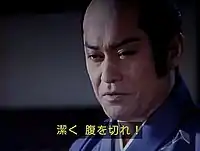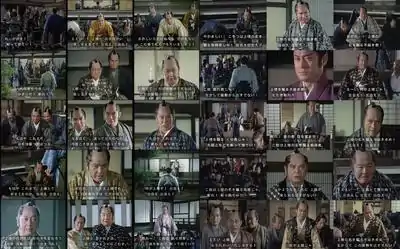The Unfettered Shogun
The Unfettered Shogun[1] (暴れん坊将軍) (Abarenbō Shōgun) is a Japanese television program on the TV Asahi network.[2] Set in the eighteenth century, it showed fictitious events in the life of Yoshimune, the eighth Tokugawa shōgun.
| The Unfettered Shogun | |
|---|---|
 Firefighters' lanterns from the Megumi | |
| Also known as | Abarenbo Shogun |
| Starring | Ken Matsudaira, Tadashi Yokouchi, Saburō Kitajima |
| Country of origin | Japan |
| No. of episodes | 831 |
| Production | |
| Running time | 45 Minutes |
| Release | |
| Original network | TV Asahi |
| Original release | January 7, 1978 – December 29, 2008 |
The program started in 1978 under the title Yoshimune Hyobanki: Abarenbo Shogun (Chronicle in Praise of Yoshimune: The Unfettered Shogun) who went after rogue councillors and daimyō who were abusing their power. After a few seasons, they shortened the first two words and ran for two decades under the shorter title until the series ended in 2003; a two-hour special aired in 2004. The earliest scripts occasionally wove stories around historic events such as the establishment of firefighting companies of commoners in Edo, but eventually the series adopted a routine of strictly fiction.
Along with Zenigata Heiji and Mito Kōmon, it ranks among the longest-running series in the jidaigeki genre. Like many other jidaigeki, it falls in the category of kanzen-chōaku, loosely, "rewarding good and punishing evil".
Repeating characters
Regulars

- Disguised as Tokuda Shinnosuke—Shin-san to his friends—the third son of a hatamoto, the shogun roams freely about his capital, using the Megumi fire company as his base. The captain of the company knows his identity, but others are unaware that he is the shogun. Yoshimune-as-Shinnosuke is portrayed as the nearly invincible samurai warrior who seldom loses a fight no matter how many enemies opposing him there are.
Ōoka Echizen-no-Kami Tadasuke
- Like Yoshimune, Tadasuke was a historical personage. Yoshimune appointed him to the position of Minami Machi Bugyō, one of the two chief administrators of Edo. In this office, he was mayor, police chief, judge and jury. He instituted and oversaw the operations of the commoners' fire companies. He also oversaw the Koishikawa "City Hospital" (Koishikawa Yōjōsho, another Yoshimune innovation). He was aware of Yoshimune's secret activities and originally did not approve, but grew to accept them as necessary and was a loyal accomplice. In the first episode, it was revealed that when he was Yamada Magistrate he had once reprimanded Yoshimune for illegal fishing when the shogun was younger, proving both his integrity and his devotion to the law.
- Tadashi Yokouchi played Tadasuke for nearly twenty years; Ryō Tamura replaced him in the closing seasons.
Goyō toritsugi
- The goyō toritsugi (御用取次) or soba yōnin (側用人) was the person who scheduled appointments for the Shogun. He is generally a man of advanced years. In the first two casts, the character's name was Kanō Gorozaemon (played by comic Ichirō Arishima). Next came Tanokura Magobei (Eiji Funakoshi), and a few followed in the cast changes of the last years of the show.
.jpg.webp)
Fire captain
- Tatsugoro, originally the boss of a construction gang, was the founder of the Megumi fire company and thus reported directly to Tadasuke. In the first episode, it was revealed that he was a former drinking and fighting companion of Yoshimune's before the young lord's elevation to the shogunate. Enka singer Saburō Kitajima played in the series from beginning to end. Although somewhat short-tempered and never one to shun a brawl for a righteous cause, this short, stocky character was altruistic to a fault, stubborn, and fiercely loyal to Yoshimune.
- Kitajima also sang the closing theme songs for several years.
- Later, Tatsugorō retired from the Megumi and assumed a different occupation; the writers of the series brought in Jōji Yamamoto, another singer (and a disciple of Kitajima) to play Chōjirō, the successor to Tatsugorō. In all, there were three captains during the series.
Women of Megumi
- Three actresses played Osai, the feisty wife of Tatsugoro. Later, when Tatsugorō left the fire company, the new captain Chōjirō married Obun, the young fishmonger/beat cop. The third captain was unmarried; his widowed sister Okyō was the lady of the Megumi.
Firemen
- The cast always included half a dozen firefighters (火消 Hikeshi). While the roles were minor, together they were a prominent presence in the series. Character actors and comics played these parts.
- The fire companies were named with a single kana such as め followed by the word -gumi. The show featured the Me-gumi, whose auspicious name could also mean "blessing"; the squad was formed in the third episode "The First Fireman's Banner".
- In the first several years, a retired sumo wrestler named Ryūko was a member of the cast. He played a retired sumo wrestler named Ryūko, who was initially a guest of the captain. He later became a bone-setting doctor, and finally joined the crew of the fire company. Long after leaving the series, he made an appearance as a guest star.
Oniwaban (ninja)
- The show always had a male and a female oniwaban who acted as both spies and bodyguards for Yoshimune. A few of the actors and actresses have gone on to starring roles in other series. The original female, Osono, was played by Yōko Natsuki. Her successor, Asaka Mayumi, is currently active. In the third series, Reiko Sugano played Hayate; then Takashima Reiko, who has gone on to star in television and film, succeeded her, with the name Kozue. Mayuko Irie (Akane), Akiko Andō (Koyuki), Hitoe Ōtake (Ayame), Chika Kochihira (Satsuki), Kaori Yamaguchi (Nagisa), and Kaori Matsunaga (Azami) followed, with Miki Murai appearing in the final special as Kaede. The men include Sukehachi (portrayed by Hiroshi Miyauchi) and Ōtsuki Hanzō (Shun'ya Wazaki, opposite Osono), the first Saizō (Shigeru Araki, paired with Hayate), Sagenta (Kiyotaka Mitsugi) and the second Saizō (played by Takayuki Godai). Hayami Saheiji (Toshihide Wakamatsu), Jūmonji Hayato, and finally Gorōta followed.
Narrator
- Genzō Wakayama narrated the show from the first episode to the last.
Semi-regulars
Tokugawa Muneharu (徳川宗春)
- The historical Yoshimune came to power when the main line of succession to the Tokugawa shogunate came to an end. He was chosen from the second of the three cadet branches of the Tokugawa clan, and the head of the senior branch, Muneharu, was passed over. The television series frequently presented Muneharu as a rival who tried to assassinate Yoshimune and take over the shogunate. Even when he did not appear, many villains acted in his name, or planned to receive their reward from Muneharu when he became shogun. First played by Akira Nakao and later by Tokuma Nishioka.
Yamada Asaemon (山田朝右衛門)
- Nicknamed Kubikiri Asa. An executioner for the shogunate, he quits and becomes a rōnin and ally of Yoshimune. Asahi Kurizuka played the role in many episodes.
O-Yuri no Kata (お由利の方)
- Also known as Jōen'in (浄円院). Yoshimune's mother. Sons of samurai overlords were often separated from their mothers at an early age to develop sternness in them, and Yoshimune was no different. Although Yoshimune offered Oyuri room and board in Edo Castle, she refused, living instead an austere life in a house often seen nearly falling apart. They love each other as an ordinary mother and son, but they conceal their relationship to others as this is part of the Shinnosuke myth used by the Shogun. Played by Tamao Nakamura.
Guest stars
Over the course of a quarter of a century, the show featured a parade of celebrities. Singers, actors, and athletes of all ages played various roles, in some cases including themselves: Ryūko appeared as a guest several years after leaving the regular cast. Hibari Misora, the famous singer, also appeared in the series. Former and future regular characters occasionally made guest appearances.
Among the guest stars were the following:
Stories
The show was frequently topical, and touched on many themes of present-day life, the most common subject being political corruption. Many shows covered include topics of current interest such as drugs, unequal power relationships, poverty, urbanization, the generation gap, yakuza, prostitution, inflation, and the tension between Japanese and foreign knowledge.
Climax

At the end of about eight hundred episodes, Yoshimune confronts the corrupt official or officials in their safehaven. The official calls his men, but Yoshimune stands firm to reveal and criticize his crimes without hesitation. At first, the official behaves rudely and insultingly as he believes Yoshimune is just a man of low social status, but then after looking closely at Yoshimune's face has a flashback leading him to recognize Yoshimune as Shogun and kneel down in obeisance. However, on hearing Yoshimune's demand that he commit harakiri, he declares Yoshimune to be an impostor and orders his men to kill him. Always outnumbered, Yoshimune ends up easily defeating his attackers with the help of his male and female oniwaban. Using the unsharpened back side of his sword so as to injure without killing the corrupt official, he orders his oniwaban to execute him with the words, sei bai.[3] In the premiere episode "The Star of Edo", Yoshimune confronts the main villain as himself inside Castle Edo and the villain recognizes him as the hatamoto; after attempting to flee, being disarmed by Yoshimune and surrounded by Yoshimune's ninja and the palace guards, he is allowed to kill himself.
Lines of rebellion
In confronting Yoshimune, the official declares his rebellion with a variety of reasons, including the doubt of the appearance of the Shogun at that place and time or losing his respect to Yoshimune, etc., and it's one of the enjoyable points in the climax.
Example:

- Sir Tokugawa cannot be here
- He is an insolent person calling himself Sir Tokugawa
- It's fine if the person were Sir Tokugawa
- Everything ends, kill, kill him
- Sir Tokugawa, I will fight with you
- We lob your life, sir Tokugawa
- You are just Shinnosuke Tokuda dying now
- I decorate the last minute as an evil (to defeat you)
- You are like a moth flying into the flame
- Your Highness exists because of us, subordinates' dedication (not because of your ability)
- The eighth shogunate will end
- Now is the time
- Shame on you
- Bring his head to our lord Muneharu
- I have forgotten the face of Sir Tokugawa
- There is no reason to obey the order of sir Tokugawa
- It is you who cut your own body, not I
- We have planned to make you die
- You must give up your life
- I am a person who should have died at once (so, I'm not afraid if you try to execute me)
- If you know the situation completely, in for a penny, in for a pound
- How stupid saying who you are, it's the best timing that you show up here (to be killed)
Cast
- Ken Matsudaira as Tokugawa Yoshimune
- Tadashi Yokouchi (first), Ryō Tamura (second) as Ōoka Tadasuke
- Megumi
- Saburō Kitajima as Tatsugorō, the first captain
- Masumi Harukawa (first), Yōko Asaji (second), Ryōko Sakaguchi (third) as Osai, wife of Tatsugorō
- Jōji Yamamoto as Chōjirō, the second captain
- Akiko Ikuina as Obun, wife of Chōjirō
- Yūki Matsumura as Eigorō, third captain
- Yōko Ishino as Okyō, sister of Eigorō
- Advisors to Yoshimune
- Ichirō Arishima as Kanō Gorozaemon
- Eiji Funakoshi as Tanokura Magobei
- Tadao Takashima as Shishido Kanbei
- Shigeru Kōyama as Yokokawa Kanjūrō
- Oniwaban (ninja)
- Hiroshi Miyauchi as Yabuta Sukehachi
- Yōko Natsuki as Osono
- Shigeru Araki as Koba Saizō
- Asaka Mayumi as Sagiri
- Kiyotaka Mitsuki as Sagenta
- Takayuki Godai as Saizō
- Reiko Sugano as Hayate
- Reiko Takashima as Kozue
- Mayuko Irie as Akane
- Tarō Iketani as Kirihara Sasuke
- Toshihide Wakamatsu as Hayami Saheiji
- Akiko Andō as Koyuki
- Takahito Ōmori as Jūmonji Hayato
- Hitoe Ōtake as Ayame
- Chika Kochihira as Satsuki
- Kaori Yamaguchi as Nagisa
- Miki Murai as Kaede
- Akira Nakao (first), Tokuma Nishioka (second) as Tokugawa Muneharu
- Asahi Kurizuka as Yamada Asaemon
- Tamao Nakamura as Oyuri, mother of Yoshimune
- Tsukasa Ito as Oyō, intern at the Koishikawa Yōjōsho
- Azusa Nakamura as Tsuruhime/Chizuru, love interest of Yoshimune
- Megumi Matsushita as Chinatsu, niece of Ōoka Tadasuke
Music
Shunsuke Kikuchi wrote the opening theme, which is popular as a ring tone. He also composed the incidental music. Saburō Kitajima sang the closing theme songs to various series. Late series omitted the closing theme, having instead introductory music by Kikuchi leading into an opening theme song sung by Kitajima. Due to the show's popularity in the Hawaiian islands where a large portion of the population is Japanese, the opening theme has become one of the official sports themes played at University of Hawaii sporting events.
Broadcasts
The original broadcasts were on the TV Asahi network in Japan. The Jidaigeki Senmon Channel has rebroadcast the series on cable and satellite. Also, full English-subtitled programs have been broadcast in Hawaii via KIKU[4][5] and have become very popular even among younger generations probably due to the large Japanese-American population and heavy Asian influence on modern Hawaiian culture.
Episode list
1
- The Star of Edo (春一番! 江戸の明星)
- The Remarkable Charlatan (素晴らしき藪医者)
03-The First Fireman Banner 04-Mother From Long Past 05-Spring in the O'oku 06-The Splendid Potato Samurai 07-The Man of River Styx 08-The Befouled Truncheon 09-The Chivalrous Thief 10-The Blossoming Meyasubako 11-The Finest Kiyari Song 12-The Amazing Kishu Woman 13-The Perilous Souvenir Gift 14-The Golden Crow Charms 15-The Quack Who Calls Forth Spring 16-Showdown at Beautiful Yoshiwara 17-Love and the Guardian Deity 18-The Beat of a Taiko Drum in Edo 19-A Ballad of a Fireman 20-Iris and Sympathy 21-Fireman's Standard was Watching 22-Friendships Support the World 23 Rage of the Fishmonger (怒れ!!魚河岸野郎) 24 The Dreadful Shichi-ri Messengers (七里飛脚は鬼より恐い) 25 Heavens! Great Trouble in Edo (素破!天下の一大事) 26 The Drunken Man Who Was Promoted (朝寝朝酒で出世した男)
11 (XI)
- Yoshimune, Surviving the Flames (吉宗、炎の生還)
- め組から消えた少女
- め組消滅の危機!
- 女医の恋した町奉行
- 爺が引退! 吉宗苦悩の決断
- お杏が殺した男!?
- 父恋し! 涙の子守唄
- お杏の悲痛な叫び! 夫はなぜ殺された!?
- 命を賭けた献上刀
- め組に舞い降りた天女!
- 徳田新之助殺人事件!!
- 女たちの戦さ! 先妻VS後妻
- ムコ殿は上様?
- 鬼と呼ばれたい女!
- 時効を待つ女
- め組出入り禁止令! 子守りをする吉宗
- 危機一髪! お庭番の禁じられた恋
- 吉宗、人生最悪の日!?
- 天下無敵の悪党退治!
12 (XII)
- 美しき狙撃者! 和歌山城燃ゆ!!
- 南紀白浜の謀略! 吉宗の娘を生んだ女?!
- 老盗賊の復讐! 捨てられた千両箱の謎
- The Lords Sets a Trap (にわか殿様が仕掛けた罠)
- 女盗賊と駆け落ちした町火消し!
- 怪盗キツネ小僧! 裏切られた幼な心!!
- Dubious Clan Successor (疑惑の家督相続! 吉宗と二世を誓った女)
- His Toughest Decision (大岡越前切腹!! 吉宗、苦悩の決断!)
- Clairvoyant Osaki (江戸に大火事! 百発百中!?千里眼の女)
- 雨の目撃者! 牢獄に通う吉宗の母
References
- "Library -- English Titles -- TOEI TV Website". 29 October 2013. Retrieved 14 August 2018.
- テレビ朝日|暴れん坊将軍 Rekishi Hakubutsukan (history of Abarenbō Shōgun at TV Asahi) Retrieved on December 7, 2008
- "Archived copy" (PDF). Archived from the original (PDF) on 2007-09-30. Retrieved 2006-08-18.CS1 maint: archived copy as title (link)
- "Abarenbo Shogun". 21 March 2006. Retrieved 14 August 2018.
- "Abarenbo Shogun VII". 21 March 2006. Retrieved 14 August 2018.